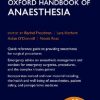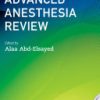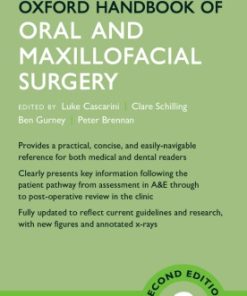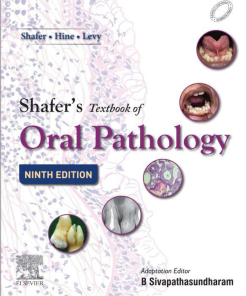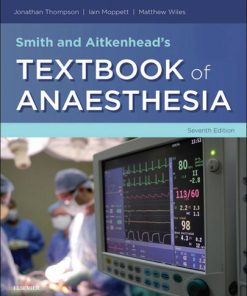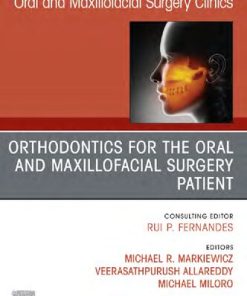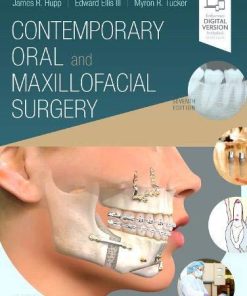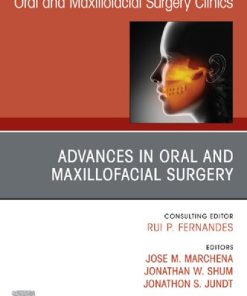Oxford Textbook of Anaesthesia for Oral and Maxillofacial Surgery 2nd Edition by Patrick Ward, Michael Irwin 0192508083 9780192508089
$50.00 Original price was: $50.00.$25.00Current price is: $25.00.
Oxford Textbook of Anaesthesia for Oral and Maxillofacial Surgery 2nd Edition by Patrick A. Ward, Michael G. Irwin – Ebook PDF Instant Download/DeliveryISBN: 0192508083, 9780192508089
Full download Oxford Textbook of Anaesthesia for Oral and Maxillofacial Surgery 2nd Edition after payment.
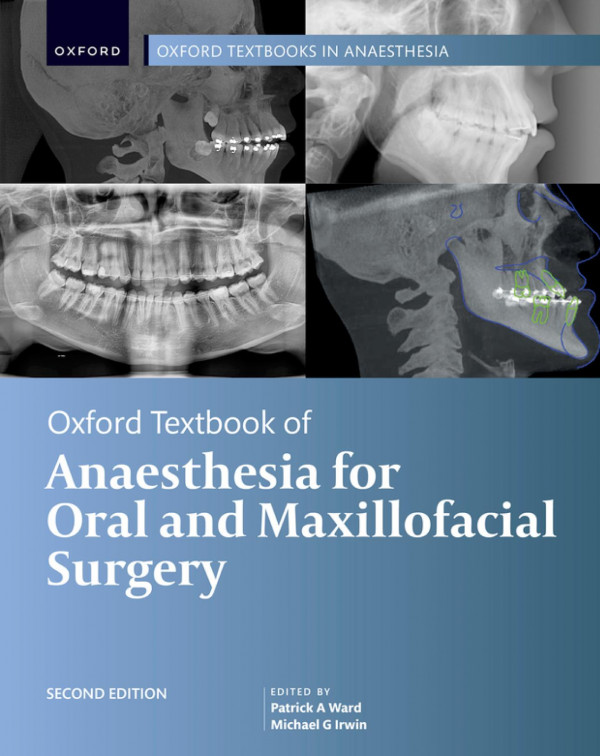
Product details:
ISBN-10 : 0192508083
ISBN-13 : 9780192508089
Author : Patrick A. Ward, Michael G. Irwin
Providing safe, effective anaesthesia for patients undergoing oral and maxillofacial surgery presents unique challenges involving a wide range of complex procedures, treatments, and interventions to manage an array of pathologies.
This textbook is a practical, easy to read and engaging guide to the entire perioperative management process, encompassing everything that the practitioner needs to know. It utilises a clear, step-by-step approach to managing all aspects of anaesthesia for oral and maxillofacial surgery, from routine elective procedures to emergencies, difficult airways, cancer, and pain. A contemporary, evidence based approach and the most up-to-date techniques are described, with reference to current guidelines and standards. This comprehensive second edition will empower the novice, but also support more experienced practitioners and those who may occasionally be called upon to manage emergency cases.
Oxford Textbook of Anaesthesia for Oral and Maxillofacial Surgery 2nd Table of contents:
1. Preoperative assessment
Introduction
Range of procedures
Airway evaluation and planning
Pathology-specific considerations
Environmental considerations
Evaluation of comorbidities
Preoperative risk stratification
Perioperative management of medications
Conclusion
2. Difficult airway
Introduction
Airway assessment
The airway plan
Positioning
Preoxygenation
Neuromuscular blockade
Apnoeic oxygenation
Bag mask ventilation
Supraglottic airway devices
Direct laryngoscopy
Videolaryngoscopy
Awake tracheal intubation
Fibreoptic intubation
Awake videolaryngoscopy
Awake tracheostomy
Retrograde intubation
Blind nasal intubation
Cricothyroidotomy
Intubation for maxillomandibular fixation
Tracheal extubation
Human factors
Conclusion
3. Surgical airway
Introduction
Anatomy
Elective tracheostomy
Percutaneous dilatational tracheostomy
Surgical tracheostomy
Complications of surgical and percutaneous tracheostomy
Submental tracheal intubation
Emergency front of neck airway
Use of ultrasound
Conversion techniques
Retrograde intubation
Jet oxygenation
Conclusion
Acknowledgements
4. Regional anaesthesia
Introduction
The face
Anaesthetizing the face
The scalp
Anaesthetizing the scalp
The nasal cavity
Anaesthetizing the nasal cavity
The mouth
Anaesthetizing the mouth
The pharynx
Anaesthetizing the pharynx
The larynx
Anaesthetizing the larynx
Awake tracheal intubation
Complications of regional anaesthesia
Conclusion
5. Imaging
Introduction
Imaging modalities
Trauma imaging
Dentition
Craniofacial anatomy
Craniofacial fractures
Infection
Tumours
Conclusion
6. Sedation
Introduction
Aims of sedation
Advantages of sedation
Potential complications of sedation
The ideal sedative agent
Pharmacology of sedative agents
Synergy of agents
Conduct of sedation
Conduct of surgery
Safety and guidelines
Preoperative assessment and preparation
Monitoring
Equipment availability
Training and personnel
Recovery and discharge
Conclusion
7. Hypotensive anaesthesia
Introduction
Background
Physiology
Indications
Contraindications
Conduct of deliberate hypotensive anaesthesia
Pharmacological techniques for hypotensive anaesthesia
Non-pharmacological techniques to minimize blood loss
Conclusion
8. Dental anaesthesia
Introduction
Background and history
Preoperative assessment
Consent
Anaesthesia
Postoperative complications and follow-up
Sedation
Conclusion
9. Aesthetic surgery
Introduction
Orofacial aesthetic surgery
Preoperative assessment
Anaesthesia for orofacial aesthetic procedures
Surgical requirements for orofacial aesthetic procedures
Postoperative priorities for orofacial aesthetic surgery
Considerations for specific orofacial surgical procedures
Considerations for non-surgical facial aesthetic procedures
Revision surgery
Acknowledgements
10. Orthognathic surgery
Introduction
Preoperative assessment, preparation, and planning
Preoperative consent and premedication
Intraoperative management
Tracheal extubation and emergence
Postoperative management
Specific orthognathic procedures
Conclusion
11. Paediatric surgery
Introduction
Preoperative evaluation
Premedication
Fasting
Identification of the difficult airway and its management
Induction of anaesthesia
Tracheal tube selection
Fluid management
Analgesia
Postoperative nausea and vomiting
The compromised airway in the postoperative period
Oromaxillofacial procedures
Craniofacial procedures
Orthognathic procedures
Anaesthesia for craniofacial and orthognathic procedures
Surgery for trauma
Minor oromaxillofacial procedures
Conclusion
12. Infection
Introduction
Epidemiology
Pathophysiology
Microbiology
Antimicrobials
Antibiotic prophylaxis
Clinical assessment
Management of the uncomplicated patient
Management of the patient with serious complications
Tracheal extubation and postoperative management
Secondary infections
Conclusion
13. Trauma
Introduction
Epidemiology and aetiology
Classification of fractures
Associated injuries
Emergency airway management
Airway guidelines and maxillofacial trauma
Anaesthetic management of maxillofacial trauma
Conclusion
14. Burns and inhalational injury
Introduction
Epidemiology
The emergency department acute major burn admission
Resuscitation
Secondary survey
Inhalation injury
Systemic gaseous toxins
Thermal injury to the airway
Smoke injury to the lungs
Chemical burns
Other considerations in patients with airway burns
Prognosis in the airway burns patient
Critical care therapy
Immediate major burn debridement
General considerations in burns anaesthesia
Burns pharmacology
Long-term considerations
Conclusion
15. Malignancy
Introduction
Anatomical distribution of malignancy
Risk factors for malignancy
Types of surgical procedures
Treatment options
Anaesthetic assessment
Fourth National Audit Project
Difficult Airway Society 2015 guidelines
Awake airway management techniques
Oxygenation techniques
Airway devices
Anaesthesia and perioperative care
Tracheal extubation techniques
Range of procedures
Conclusion
16. Postoperative care and planning
Introduction
Enhanced Recovery After Surgery
Postoperative levels of care and monitoring
Anaesthetic considerations
Oral hygiene
Tissue oedema
Cognitive recovery
Difficult airway identification
Analgesia
Obstructive sleep apnoea syndrome
Venous thromboprophylaxis
Perioperative nutrition
Neurological sequelae
Perioperative antimicrobials
Procedure-specific considerations
Conclusion
17. Surgical complications
Introduction
Airway management
Extubation planning and postoperative airway compromise
Return to theatre!
Bleeding
Infection
Other perioperative complications
Procedure-specific complications
Conclusion
18. Non-technical skills
Introduction
Anaesthetic non-technical skills (ANTS) framework
Challenges of oromaxillofacial anaesthesia
Task management
Situation awareness
ANTS applied to situation awareness
Decision-making
ANTS applied to decision-making
Teamwork
ANTS applied to teamwork
Team communication
Team performance
Crisis resource management and simulation training
Cognitive aids
Continued path towards improving patient safety
Conclusion
19. Orofacial pain
Introduction
Assessment for orofacial pain
Classification
Specific chronic orofacial pain disorders
Conclusion
People also search for Oxford Textbook of Anaesthesia for Oral and Maxillofacial Surgery 2nd:
oxford anesthesia management
oxford textbook of anaesthesia
oxford anesthesia policy
anesthesia textbook pdf
oxford anesthesia management llc
Tags: Oxford Textbook, Anaesthesia, Oral, Maxillofacial Surgery, Patrick Ward, Michael Irwin
You may also like…
Medicine - Dentistry
Medicine - Dentistry
Uncategorized


